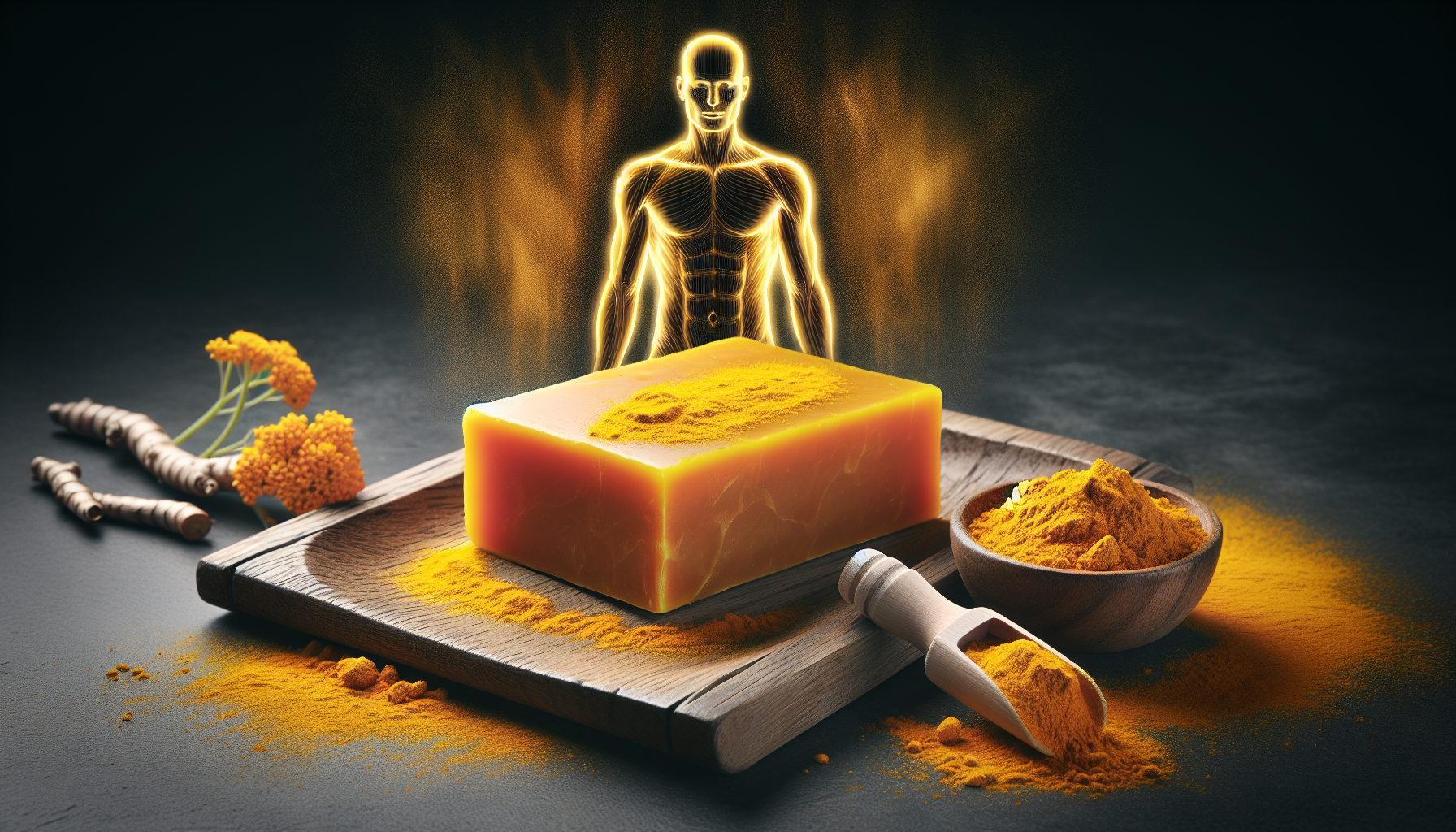Alright, picture this: you’re browsing through the aisles of your local supermarket, looking for the perfect soap. Suddenly, your eyes fall upon a bright yellow bar of turmeric soap, claiming to have numerous benefits for your skin. Intrigued, you wonder, can you actually wash your whole body with this soap? Is it just another trendy product, or does it hold some hidden secrets that could revolutionize your skincare routine? Today, we’re going to explore the world of turmeric soap and uncover whether it’s truly a one-stop solution for cleansing your entire body. So grab a cup of tea, sit back, and let’s dive into the world of turmeric soap.

Benefits of using turmeric soap
Turmeric soap offers a range of benefits for your skin. From reducing inflammation to improving skin tone, this natural soap can be a fantastic addition to your skincare routine. Let’s take a closer look at some of the advantages of using turmeric soap.
Reduces inflammation
One of the primary benefits of turmeric soap is its ability to reduce inflammation. Turmeric contains a compound called curcumin, which has anti-inflammatory properties. By using turmeric soap regularly, you can help calm and soothe inflamed skin conditions such as rashes, redness, and irritation.
Improves skin tone
Another advantage of turmeric soap is its ability to improve skin tone. The natural antioxidants present in turmeric help combat free radicals, which can cause dullness and uneven skin tone. Regular use of turmeric soap can leave your skin looking brighter, more even, and refreshed.
Fades dark spots and acne scars
Turmeric soap is also known for its ability to fade dark spots and acne scars. The curcumin in turmeric has lightening properties that can help reduce the appearance of hyperpigmentation and discoloration caused by acne or sun damage. Over time, consistent use of turmeric soap can help even out your skin tone and minimize the visibility of scars and dark spots.
Promotes wound healing
Turmeric soap has been found to promote wound healing. The antibacterial and antiseptic properties of turmeric can help prevent infections and support the healing process of minor cuts, scrapes, and abrasions. By using turmeric soap on areas with small wounds, you can aid in the process of healing and minimize the risk of infection.
Ingredients in turmeric soap
Understanding the ingredients in turmeric soap is essential to appreciate its benefits fully. Let’s take a closer look at the key components that make turmeric soap such an effective skincare solution.
Turmeric powder
Naturally, turmeric soap contains turmeric powder as its primary ingredient. Derived from the turmeric plant’s roots, turmeric powder is rich in curcumin, the compound responsible for its numerous therapeutic properties. This vibrant yellow spice is known for its anti-inflammatory, antioxidant, and antimicrobial effects, making it an excellent addition to your skincare routine.
Coconut oil
Coconut oil is another key ingredient found in turmeric soap. Coconut oil has moisturizing properties that can help keep your skin hydrated and soft. It also contains lauric acid, which has antimicrobial properties that can combat bacteria and fungi on the skin’s surface. When combined with turmeric powder, coconut oil helps create a nourishing and cleansing soap.
Shea butter
Shea butter is a luxurious ingredient commonly used in skincare products for its moisturizing and emollient properties. It is extracted from the nuts of the shea tree and is rich in vitamins and fatty acids that nourish and protect the skin. The addition of shea butter in turmeric soap provides added hydration and helps improve the overall texture and feel of your skin.
Essential oils
Depending on the specific formulation of turmeric soap, various essential oils may be added for their aromatic and therapeutic effects. Essential oils such as lavender, tea tree, or chamomile can provide additional benefits, such as calming the skin, soothing irritation, or providing a pleasant scent to the soap.
Making homemade turmeric soap
If you’re interested in incorporating turmeric soap into your skincare routine, making it at home can be a fun and rewarding process. Here is a simple guide to making your own homemade turmeric soap.
Gather the ingredients
To make homemade turmeric soap, you will need the following ingredients: turmeric powder, soap base (such as melt-and-pour glycerin soap base), coconut oil, shea butter, and any desired essential oils.
Measure and melt the soap base
Begin by measuring the desired amount of soap base and cutting it into smaller pieces. Place the soap base in a microwave-safe bowl and microwave it in short intervals until it melts completely. Alternatively, you can melt the soap base using a double boiler on the stovetop.
Add turmeric powder
Once the soap base has melted, add turmeric powder to the mixture. The amount of turmeric powder you use will depend on your preference and the desired intensity of the yellow color. Stir the mixture well to ensure that the turmeric powder is evenly distributed throughout the soap base.
Mix in additional ingredients
Next, add coconut oil, shea butter, and any desired essential oils to the melted soap base and turmeric mixture. Stir thoroughly to combine all the ingredients. This step is essential to incorporate the moisturizing benefits of coconut oil and shea butter into your homemade turmeric soap.
Pour the mixture into soap molds
Carefully pour the soap mixture into soap molds of your choice. Silicone molds are excellent options as they make it easy to remove the soap once it has hardened. Gently tap the molds on a flat surface to remove any air bubbles that may have formed.
Allow the soap to cool and harden
Place the filled soap molds in a cool and dry location and allow the soap to cool and harden completely. This process typically takes a few hours or overnight. Once the soap has hardened, gently remove it from the molds and store it in a well-ventilated area to continue drying and hardening for a few more days before using.
Using turmeric soap on the body
Now that you have your homemade turmeric soap ready, it’s time to learn how to use it effectively on your body. Follow these steps for the best results:
Wet the skin
Before lathering the soap, wet your skin thoroughly with warm water. This helps open up your pores and prepares your skin for cleansing.
Lather the soap in your hands or onto a washcloth
Take the turmeric soap bar and either lather it directly in your hands or rub it onto a washcloth or loofah. Work up a rich lather to ensure proper coverage and cleansing.
Gently massage the soap onto your body
Once you have a good lather, gently massage the soap onto your body in circular motions. Pay attention to areas that may require extra attention, such as elbows, knees, or areas with acne or scars.
Rinse thoroughly
After massaging the soap onto your body, rinse off thoroughly with warm water. Make sure to remove all traces of soap to avoid any residue that may cause irritation.
Pat dry with a clean towel
Once you have rinsed off, gently pat your skin dry with a clean towel. Avoid rubbing your skin too vigorously, as this can cause unnecessary friction and potentially irritate the skin.

Precautions to consider
While turmeric soap can offer numerous benefits for your skin, it’s important to consider a few precautions before incorporating it into your skincare routine:
Perform a patch test
Before using turmeric soap on your entire body, perform a patch test on a small area of your skin first. Apply a small amount of the soap and wait 24 hours to see if any adverse reactions occur. If you experience any itching, redness, or irritation, discontinue use.
Avoid using on open wounds
Although turmeric soap can promote wound healing, it’s important to avoid using it on open wounds. The soap may sting or irritate the area, hindering the healing process. Instead, focus on applying it to intact skin.
Consult with a dermatologist
If you have any specific skin concerns or conditions, it’s always a good idea to consult with a dermatologist before using turmeric soap. They can provide personalized advice and ensure that it’s suitable for your skin type.
Avoid excessive use
While turmeric soap can provide numerous benefits, excessive use may lead to skin staining. Turmeric has a natural yellow pigment, which can temporarily discolor the skin, especially if used in excess. Use turmeric soap in moderation and in line with your skin’s needs.
Skin conditions that can benefit from turmeric soap
Turmeric soap can be particularly beneficial for individuals who have specific skin conditions. Here are a few skin conditions that may benefit from using turmeric soap:
Acne
Turmeric soap’s anti-inflammatory and antimicrobial properties make it an excellent choice for individuals dealing with acne. It can help reduce inflammation, fight acne-causing bacteria, and fade acne scars, promoting clearer and healthier skin.
Eczema
Eczema is a skin condition characterized by red, itchy, and inflamed patches. Turmeric soap’s anti-inflammatory properties can help soothe eczema flare-ups and provide relief from itching and irritation.
Psoriasis
Similar to eczema, psoriasis is a chronic inflammatory skin condition that causes red, scaly patches. Turmeric soap’s anti-inflammatory properties can help calm psoriasis flare-ups and alleviate discomfort.
Hyperpigmentation
Hyperpigmentation refers to dark patches or spots on the skin caused by increased melanin production. Turmeric soap’s lightening properties can help fade hyperpigmentation and even out skin tone over time.
Alternatives to turmeric soap
If turmeric soap doesn’t suit your preferences or you’re looking for alternative ways to incorporate turmeric into your skincare routine, there are a few options worth considering:
Turmeric face masks
Using turmeric in face masks can provide similar benefits to turmeric soap. Mixing turmeric powder with ingredients such as honey, yogurt, or milk can create a nourishing and exfoliating mask that helps brighten the skin and improve its texture.
Turmeric supplements
If you prefer internal consumption of turmeric, turmeric supplements in the form of capsules or powders are available. These supplements contain concentrated amounts of curcumin and can support your overall health and well-being.
Potential side effects of turmeric soap
While turmeric soap is generally safe to use, it’s important to be aware of potential side effects that may occur:
Skin staining
Due to its natural yellow pigment, turmeric soap may temporarily stain the skin. This staining is usually temporary and fades over time.
Allergic reactions
Although rare, some individuals may experience allergic reactions to turmeric or other ingredients present in turmeric soap. If you notice any signs of an allergic reaction, such as itching, swelling, or hives, discontinue use immediately.
Conclusion
Incorporating turmeric soap into your skincare routine can be a wonderful way to harness the many benefits of this natural ingredient. From reducing inflammation and improving skin tone to fading dark spots and promoting wound healing, turmeric soap offers a range of advantages for your skin.
Remember to always use caution and listen to your skin’s needs. Perform a patch test, avoid using on open wounds, consult with a dermatologist if needed, and avoid excessive use. Whether you choose to make your own homemade turmeric soap or opt for commercially available options, adding turmeric soap to your skincare regimen can be an effective and natural way to enhance the health and appearance of your skin.

